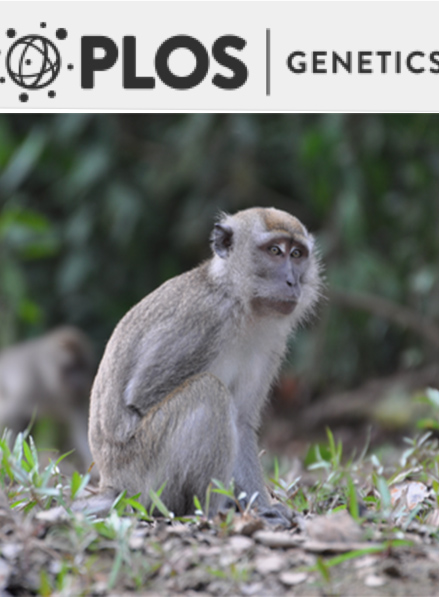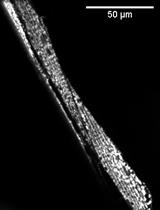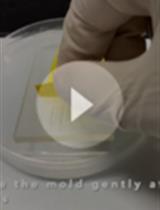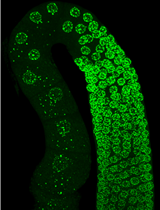- EN - English
- CN - 中文
FRAP: A Powerful Method to Evaluate Membrane Fluidity in Caenorhabditis elegans
荧光漂白恢复:一种评估秀丽隐杆线虫膜流动性的有效方法
发布: 2018年07月05日第8卷第13期 DOI: 10.21769/BioProtoc.2913 浏览次数: 10059
评审: Tugsan TezilKelly H. OhAnonymous reviewer(s)
Abstract
FRAP (Fluorescence Recovery After Photobleaching) is probably the most direct method to investigate the dynamics of molecules in living cells. Here, we describe FRAP to quantify membrane fluidity in C. elegans. Using FRAP, we have shown that cold, glucose and exogenous saturated fatty acids can decrease the fluidity of cellular membranes in certain mutants.
Keywords: FRAP (荧光漂白恢复)Background
Biological membranes, defining features of all cells, are primarily composed of phospholipids (Van Meer et al., 2008). The fatty acid species present in the phospholipid bilayer greatly influence its properties. For example, a high saturated fatty acid content increases membrane rigidity while a high unsaturated fatty acid content promotes fluidity (Pilon, 2016). The fatty acid composition of cellular membranes often shows clear correlations with the composition of dietary fats, which can be incorporated directly into phospholipids (Abbott et al., 2012; Dancy et al., 2015). However, considering that wide variations in diets exist, cells must have regulatory mechanisms that monitor and adjust membrane composition and achieve the desired membrane properties, such as fluidity, curvature, thickness, etc. Using FRAP on worms that express a prenylated GFP in intestinal cells, we have previously shown that mutants lacking PAQR-2, a homolog of the mammalian adiponectin receptors, have reduced membrane fluidity upon cultivation in the presence of glucose or on diets rich in saturated fatty acids (Svensk et al., 2016; Devkota et al., 2017). During FRAP, fluorescent molecules in a specified region are photobleached using a high-power laser and subsequent recovery of the bleached region is recorded and quantified (Reits and Neefjes, 2001). Here we describe a detailed FRAP protocol to study the fluidity of membranes in C. elegans.
Materials and Reagents
- Petri dish (60 x 15 mm) with cams (SARSTEDT, catalog number: 82.1194.500 )
- Microscope frosted slides 25 x 75 x 1 mm (Thermo Fisher Scientific, catalog number: 2951-001T )
- Microscope cover glass 22 x 22 mm (VWR, catalog number: 631-1570 )
- 0.2 μm filter (polyethylenesulfone membrane, VWR, catalog number: 28145-501 )
- C. elegans strains QC114 {etEx2 [(pQC09.6) glo-1p::GFP::ras-2 CAAX + (pRF4) rol-6(su1006)]} and QC129 (paqr-2[tm3410]) (Caenorhabditis Genetics Center/CGC, University of Minnesota, USA)
- E. coli OP50 strain (CGC, University of Minnesota, USA)
- Levamisole (Sigma-Aldrich, catalog number: L9756 )
- Potassium phosphate monobasic (KH2PO4) (Sigma-Aldrich, catalog number: 795488 )
- Potassium phosphate dibasic (K2HPO4) (Sigma-Aldrich, catalog number: P2222 )
- Sodium Chloride (NaCl) (Sigma-Aldrich, catalog number: 31434 )
- Bacto Peptone (BD, catalog number: 211677 )
- Agar Powder (VWR, catalog number: 20767.298 )
- Cholesterol (Sigma-Aldrich, catalog number: C8667 )
- Magnesium Sulfate (Sigma-Aldrich, catalog number: M2643 )
- Calcium Chloride (Sigma-Aldrich, catalog number: C8106 )
- Agarose (Sigma-Aldrich, catalog number: A9539 )
- α-D-glucose (Sigma-Aldrich, catalog number: 158968-500G )
- Ethanol (95%, Solveco, catalog number: 1000 )
- Phosphate buffer (see Recipes)
- M9 buffer (see Recipes)
- Nematode Growth Media (NGM) (see Recipes)
- Agarose pads (see Recipes)
- Levamisole solution (see Recipes)
Equipment
- Standard incubators for worm maintenance (cooled incubator by Panasonic/Sanyo, model: MIR 254 )
- 40x water immersion objective
- Stereomicroscope (Leica Microsystems, model: Leica MZ75 )
- Laser Scanning Confocal Microscope (ZEISS, model: LSM 700 )
Software
- Zen 2012 SP5 software (ZEISS)
- Microsoft Excel for Mac 2011
Procedure
文章信息
版权信息
© 2018 The Authors; exclusive licensee Bio-protocol LLC.
如何引用
Devkota, R. and Pilon, M. (2018). FRAP: A Powerful Method to Evaluate Membrane Fluidity in Caenorhabditis elegans. Bio-protocol 8(13): e2913. DOI: 10.21769/BioProtoc.2913.
分类
细胞生物学 > 细胞成像 > 共聚焦显微镜
您对这篇实验方法有问题吗?
在此处发布您的问题,我们将邀请本文作者来回答。同时,我们会将您的问题发布到Bio-protocol Exchange,以便寻求社区成员的帮助。
提问指南
+ 问题描述
写下详细的问题描述,包括所有有助于他人回答您问题的信息(例如实验过程、条件和相关图像等)。
Share
Bluesky
X
Copy link













